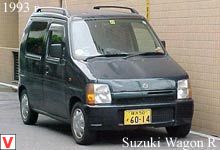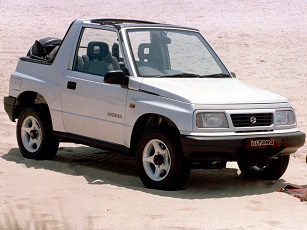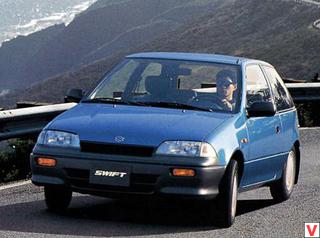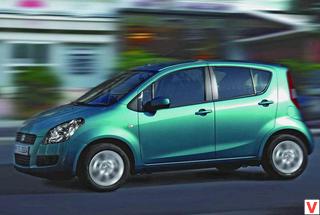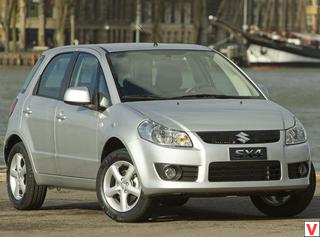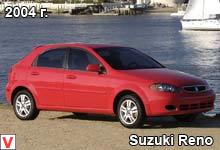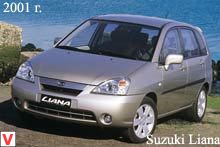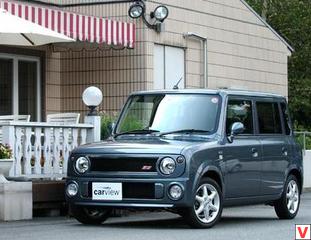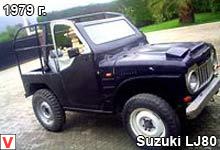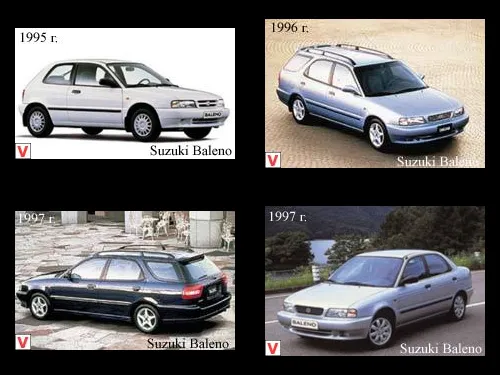
Suzuki Baleno is a car acting in the European size class C or, as it is also called, the Golf class. In the domestic market of Japan, it was named Suzuki Cultus, in the USA - Esteem. The first model with a sedan was shown in 1995. Designers awarded Baleno with a balanced and restrained appearance. Designers have provided maximum comfort for four passengers inside. Salon meets comfortable seats with excellent lateral support. Ergonomics driver's place at the proper level.
Controls are located optimally. Readings are excellent. The layout of the instruments on the panel is normal. On the left is a tachometer, in the center of the speedometer, and on the right in one round block the index of coolant temperature and fuel level are combined.
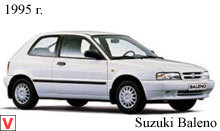
Beautiful comfortable steering wheel has a height adjustment. Gearshift levers raised up and clearly visible due to the four-spoke steering wheel. Electrically adjustable mirrors. Mirror control buttons are located to the left of the steering wheel on the dashboard. Here is the handle of the hydrocorrector headlights. But the windows are located on the driver’s armrest. In the corners of the dashboard are two large blocks of warning lamps.
In the upper part of the console there are two large buttons: an alarm and a heated rear window. They are installed here, regardless of the configuration. By the way, the Suzuki Baleno comes standard with two airbags (for those sitting in the front), an immobilizer, air conditioning, velor seat upholstery, heated rear windows, and electric windows for all doors. Visibility at Baleno at a high level.
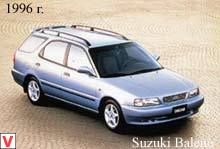
There are no dead zones. The passenger airbag swallowed the glove box volume. Therefore, it turned out a small size and is located quite low. Volume trunk, its cover rises almost vertically. The aerodynamics of the body, developed experimentally in a wind tunnel, is almost perfect.
The designers paid special attention to noise and vibration isolation: you can’t hear the engine, it’s not transmitted to the body or the suspension. Fighting noise and vibration was conducted by engineers not only at the level of body structure and aerodynamics. A new synthetic material was specially developed. They laid out in several layers all the bottom of the car, a shield separating the engine from the passenger compartment, the boot floor, the roof. Of it, special inserts have been made, which suppress resonant phenomena arising on the plastic parts of the torpedo. Designers and to the little things treated carefully.
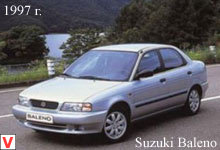
This is clearly seen in the example of plastic parts and their fitting. Very comfortable knobs, keys, to press on which does not require effort. Quality is also manifested in more serious things, such as suspension or engine. The latter deserves special attention.
For a volume of 1.3 liters is one of the most powerful powertrains. Maximum power is 85 hp (for some markets there is a variation of 92 hp). 16-valve engine with distributed injection. The engine is paired with a five-speed manual or automatic three-and four-speed gearbox. Thanks to the gearbox with short and well-chosen gears Suzuki Baleno is very dynamic. Fully independent suspension gives the car excellent stability.
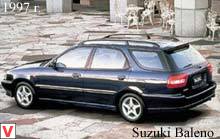
Front mounted on a powerful subframe, coupled with L-shaped levers with MacPherson struts. In addition, there is a stabilizer bar, also very powerful and located in such a way that it works through a subframe. The rear suspension is also mounted on a powerful subframe, connected to McPherson struts with two parallel rods. The subframes of the suspensions with the body are fastened through special vibration-damping pads, which are the pride of designers.
The safe body has a front structure, collapsing in a collision, and from the sides - beams that protect against side impact. The car turned out to be agile and surprisingly docile. In 1996 he debuted the Baleno Wagon in the station wagon. Universals have always enjoyed steady demand in the European market.

The advantages of cars with a cargo-passenger body are obvious - this is a large internal volume and the possibility of transforming the rear compartment. In the Baleno Wagon, everything is quite trivial: a 100-horsepower 1.6 liter engine, ABS and a practical interior. The instrument panel is concise and does not differ originality. The front seats are almost not profiled, with a very simple "anatomy". Landing high, visibility forward and on the mirrors at the proper level. Rear space enough for three. There is enough legroom in both the front and rear.
The back of the sofa, which separates the cabin from the trunk, is easily folded both in parts and completely, forming an impressive cargo area. Loading and unloading is facilitated by the low level and large width of the rear door opening. The Baleno Wagon 4WD station wagon has a full readiness for constant readiness, the main element is the RBC distributor coupling placed in front of the rear main gear. The RBC multi-plate clutch aligns the rotational speeds of the front and rear wheels. Under normal conditions, the Baleno 4WD is front-wheel drive. If necessary, for example, during acceleration and cornering, the transfer sleeve includes all-wheel drive.
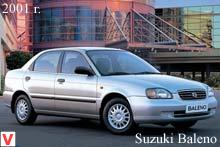
So the Suzuki Baleno Wagon is a beautiful, practical and truly versatile vehicle. After the modernization of 1998, the Baleno model has not changed much. Slightly updated the front part, which now began to adorn the high headlights. At the choice of buyers are three body options (3-door hatchback, sedan, 5-door station wagon) and three engines with a displacement of 1.3-1.8 liters and an output of 86-121 hp. Options with a 1.6-liter engine in 96 hp can be on the all-wheel drive chassis. For some markets, the Baleno is equipped with a 1.9-liter, 75-hp Peugeot eddy-chamber diesel engine. Japanese Cultis models have 1.3-, 1.5-, 1.6- and 1.8-liter engines with an output of 85-135 hp.
According to external data, Baleno is quite possible to add to the list of the most successful in its class. The original form of the hood, balanced proportions give the car elements of originality and grace. The Baleno has a fairly high ground clearance - the sedan on 13-inch wheels is 165 mm, and the station wagon with 14-inch wheels has about 170. The body is reliably protected from corrosion: 50% (by belt) zinc, on the bottom and in the wheel arches a powerful polymer anti-corrosion coating.
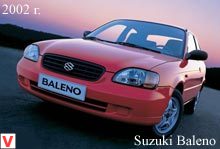
Inside is a spacious and thoughtfully arranged salon. Traditional matte plastic gray and velor, carefully fitted panels - nothing particularly outstanding, but high quality, neat and quite comfortable. There are many pockets and tanks: in the doors, in the backs of the front seats, on the front console and in the armrest.
Comfortable and free fit, ergonomic seats with a uniform distribution of body weight over the entire area (the option of a complete set of sports seats is possible) and adjustable angle of inclination of the pillow. Glass devices with anti-reflective coating, large and clear white numbers on a dark background are perfectly distinguishable. Very good visibility. The standard equipment is very rich: all electric windows and mirrors, central locking, heated seats, radio preparation, adjustable steering column, variable power steering, ABS, immobilizer. For an additional fee - air conditioning, fog lights, alloy wheels, remote control of the central lock.
In addition to the two airbags and seat belts with height adjustment, safety is provided by beams built into all doors. Enough "sharp" steering, with a good reactive action. Four-wheel drive is implemented through a viscous coupling, and in normal mode, the torque is distributed between the front and rear axle in the ratio of 95: 5. As soon as the front wheels start to slip, the rear wheels are immediately connected, the car leveled, noticeably stays better on the ice and turns more confidently.
The fully independent suspension is stiff, the unevenness of the road is felt more strongly, but it perfectly dampens the rolls, longitudinal and transverse vibrations; clings tightly to the road, ensuring decent road holding. ABS is activated only when absolutely necessary. Suzuki Baleno Wagon is a nice, well-made Japanese-made car. Reliable and affordable, it is designed for practitioners of practical solutions.
